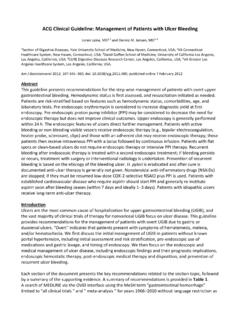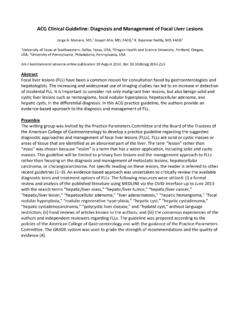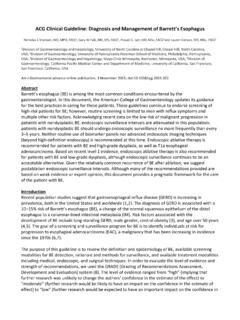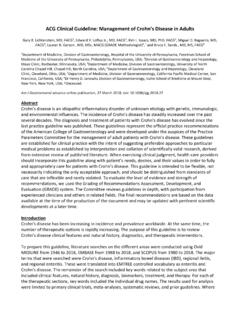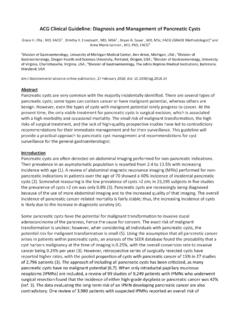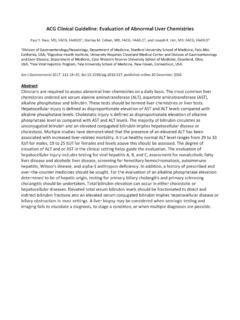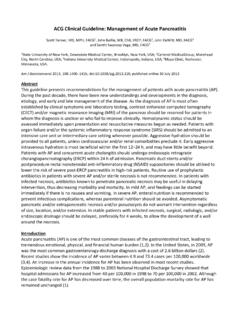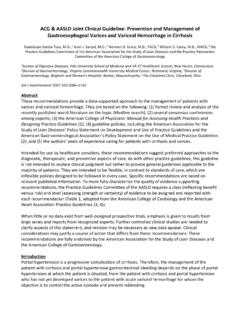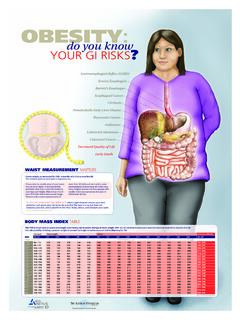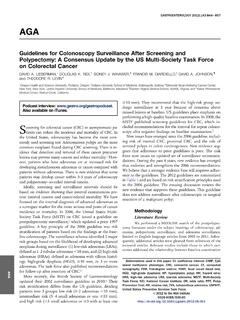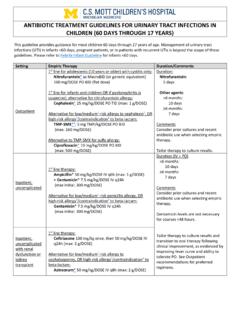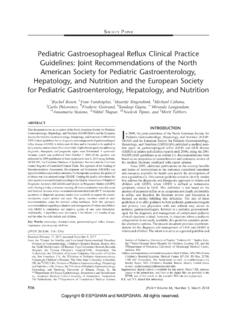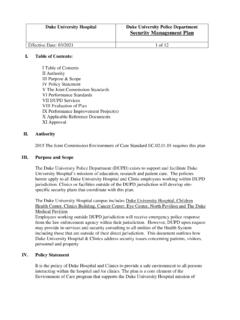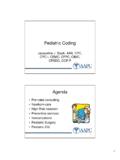Transcription of ACG Clinical Guideline: Diagnosis and Management of Celiac …
1 ACG Clinical Guideline: Diagnosis and Management of Celiac Disease Alberto Rubio-Tapia, MD1, Ivor D. Hill, MD2, Ciar n P. Kelly, MD3, Audrey H. Calderwood, MD4 and Joseph A. Murray, MD1 1 Division of Gastroenterology and Hepatology, Mayo Clinic, Rochester, Minnesota, USA; 2 Department of Pediatrics, Wake Forest University School of Medicine, Winston-Salem, North Carolina, USA; 3 Celiac Center, Division of Gastroenterology, Beth Israel Deaconess Medical Center & Harvard Medical School, Boston, Massachusetts, USA; 4 Gastroenterology, Department of Medicine, Boston University School of Medicine, Boston, Massachusetts, USA Am J Gastroenterol 2013; 108:656 676; ; published online 23 April 2013 Abstract This guideline presents recommendations for the Diagnosis and Management of patients with Celiac disease.
2 Celiac disease is an immune-based reaction to dietary gluten (storage protein for wheat, barley, and rye) that primarily affects the small intestine in those with a genetic predisposition and resolves with exclusion of gluten from the diet. There has been a substantial increase in the prevalence of Celiac disease over the last 50 years and an increase in the rate of Diagnosis in the last 10 years. Celiac disease can present with many symptoms, including typical gastrointestinal symptoms ( , diarrhea, steatorrhea, weight loss, bloating, flatulence, abdominal pain) and also non-gastrointestinal abnormalities ( , abnormal liver function tests, iron deficiency anemia, bone disease, skin disorders, and many other protean manifestations). Indeed, many individuals with Celiac disease may have no symptoms at all.
3 Celiac disease is usually detected by serologic testing of Celiac -specific antibodies. The Diagnosis is confirmed by duodenal mucosal biopsies. Both serology and biopsy should be performed on a gluten-containing diet. The treatment for Celiac disease is primarily a gluten-free diet (GFD), which requires significant patient education, motivation, and follow-up. Non-responsive Celiac disease occurs frequently, particularly in those diagnosed in adulthood. Persistent or recurring symptoms should lead to a review of the patient s original Diagnosis to exclude alternative diagnoses, a review of the GFD to ensure there is no obvious gluten contamination, and serologic testing to confirm adherence with the GFD. In addition, evaluation for disorders associated with Celiac disease that could cause persistent symptoms, such as microscopic colitis, pancreatic exocrine dysfunction, and complications of Celiac disease, such as enteropathy-associated lymphoma or refractory Celiac disease, should be entertained.
4 Newer therapeutic modalities are being studied in Clinical trials, but are not yet approved for use in practice. Given the incomplete response of many patients to a GFD-free diet as well as the difficulty of adherence to the GFD over the long term, development of new effective therapies for symptom control and reversal of inflammation and organ damage are needed. The prevalence of Celiac disease is increasing worldwide and many patients with Celiac disease remain undiagnosed, highlighting the need for improved strategies in the future for the optimal detection of patients. Introduction This Clinical guideline addresses the Diagnosis , treatment, and overall Management of patients with Celiac disease (CD), including an approach to the evaluation of non-responsive CD. While it is primarily directed at the care of adult patients, variations pertinent to the pediatric population have been included.
5 Each section will provide specific recommendations based on the current literature and a summary of the evidence supporting those recommendations. The GRADE system was used to evaluate the quality of supporting evidence (1) (Table 1). A strong recommendation is made when the benefits clearly outweigh the negatives and the result of no action. Conditional is used when some uncertainty remains about the balance of benefit/potential harm. The quality of the evidence is graded from high to low. High -quality evidence indicates that further research is unlikely to change the authors confidence in the estimate of effect. Moderate -quality evidence indicates that further research would be likely to have an impact on the confidence of the estimate, whereas Low -quality evidence indicates that further study would likely have an important impact on the confidence in the estimate of the effect and would likely change the estimate.
6 Table 1. Criteria for assigning grade of evidence Type of evidence Randomized trial=high Observational study=low Any other evidence=very low Decrease grade if Serious ( 1) or very serious ( 2) limitation to study quality Important inconsistency ( 1) Some ( 1) or major ( 2) uncertainty about directness Imprecise or sparse data ( 1) High probability of reporting bias ( 1) Increase grade if Strong evidence of association significant relative risk of >2 (< ) based on consistent evidence from two or more observational studies, with no plausible confounders (+1) Very strong evidence of association significant relative risk of >5 (< ) based on direct evidence with no major threats to validity (+2) Evidence of a dose response gradient (+1) All plausible confounders would have reduced the effect (+1) Definition of grades of evidence High=Further research is unlikely to change our confidence in the estimate of effect Moderate=Further research is likely to have an important impact on our confidence in the estimate of effect and may change the estimate Low=Further research is very likely to have an important impact on our confidence in the estimate of effect and is likely to change the estimate Very low=Any estimate of effect is very uncertain Reprinted with permission from Camilleri et al.
7 (264). When to Test for CD Recommendations 1. Patients with symptoms, signs, or laboratory evidence suggestive of malabsorption, such as chronic diarrhea with weight loss, steatorrhea, postprandial abdominal pain, and bloating, should be tested for CD. (Strong recommendation, high level of evidence) 2. Patients with symptoms, signs, or laboratory evidence for which CD is a treatable cause should be considered for testing for CD. (Strong recommendation, moderate level of evidence) 3. Patients with a first-degree family member who has a confirmed Diagnosis of CD should be tested if they show possible signs or symptoms or laboratory evidence of CD. (Strong recommendation, high level of evidence) 4. Consider testing of asymptomatic relatives with a first-degree family member who has a confirmed Diagnosis of CD.
8 (Conditional recommendation, high level of evidence) 5. CD should be sought among the explanations for elevated serum aminotransferase levels when no other etiology is found. (Strong recommendation, high level of evidence) 6. Patients with Type I diabetes mellitus (DM) should be tested for CD if there are any digestive symptoms, or signs, or laboratory evidence suggestive of CD. (Strong recommendation, high level of evidence) Table 2. Conditions in which CD occurs more frequently than in the general population and/or for whom a GFD may be beneficial CD common (>2 times prevalence of general population) CD less common but treatable Symptomatic malabsorption Pulmonary hemosiderosis Diarrhea with weight loss Unexplained male or female infertility Chronic diarrhea with or without abdominal pain Dyspepsia Chronic iron deficiency and anemia Amenorrhea Metabolic bone disease and premature osteoporosis Chronic fatigue Postprandial bloating and gaseousness Apparent malabsorption of thyroid replacement medication Unexplained weight loss Epilepsy or ataxia Abnormal elevated liver enzymes Constipation Incidental discovery of villous atrophy endoscopically or histologically Recurrent abdominal pain Dermatitis herpetiformis Peripheral neuropathy Oral aphthous ulcers Growth failure Discolored teeth or developmentally synchronous enamel loss Thyroid disease Irritable bowel syndrome
9 Down s and Turner s syndromes Diagnosis of CD Recommendations 1. Immunoglobulin A (IgA) anti-tissue transglutaminase (TTG) antibody is the preferred single test for detection of CD in individuals over the age of 2 years. (Strong recommendation, high level of evidence) 2. When there exists a high probability of CD wherein the possibility of IgA deficiency is considered, total IgA should be measured. An alternative approach is to include both IgA and IgG-based testing, such as IgG-deamidated gliadin peptides (DGPs), in these high-probability patients. (Strong recommendation, moderate level of evidence) 3. In patients in whom low IgA or selective IgA deficiency is identified, IgG-based testing (IgG DGPs and IgG TTG) should be performed. (Strong recommendation, moderate level of evidence) 4.
10 If the suspicion of CD is high, intestinal biopsy should be pursued even if serologies are negative. (Strong recommendation, moderate level of evidence) 5. All diagnostic serologic testing should be done with patients on a gluten-containing diet. (Strong recommendation, high level of evidence) 6. Antibodies directed against native gliadin are not recommended for the primary detection of CD. (Strong recommendation, high level of evidence) 7. Combining several tests for CD in lieu of TTG IgA alone may marginally increase the sensitivity for CD but reduces specificity and therefore are not recommended in low-risk populations. (Conditional recommendation, moderate level of evidence) 8. When screening children younger than 2 years of age for CD, the IgA TTG test should be combined with DGP (IgA and IgG).
